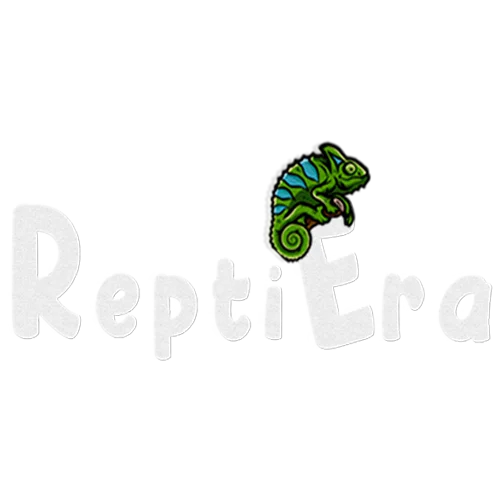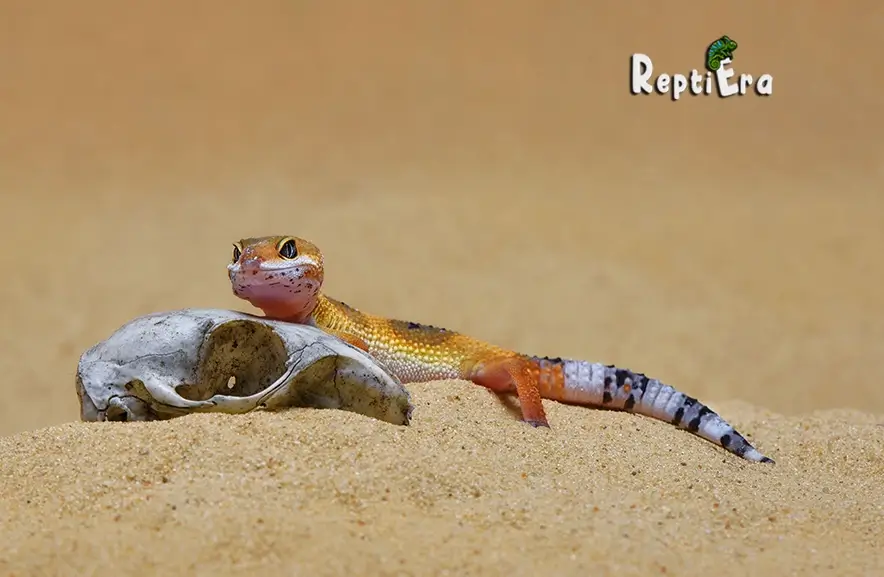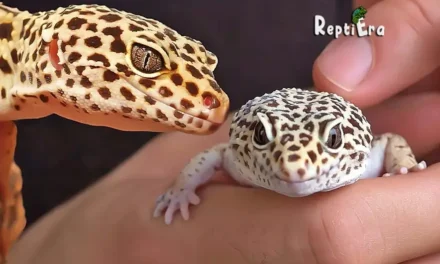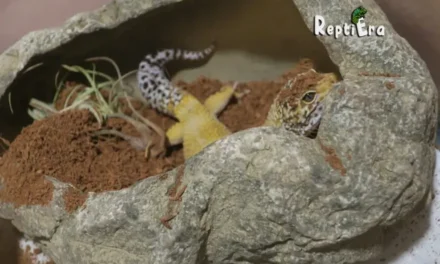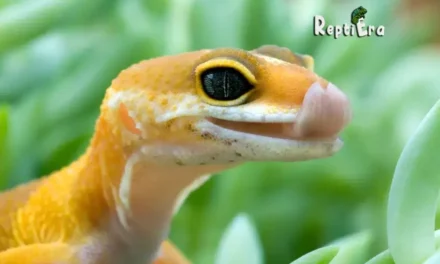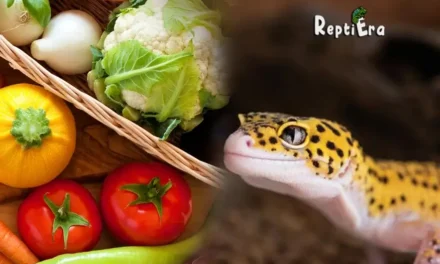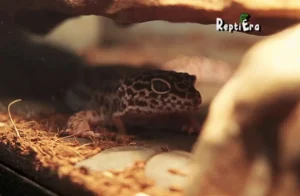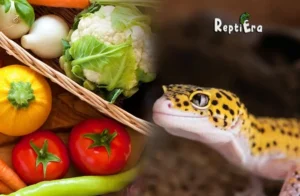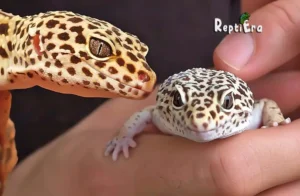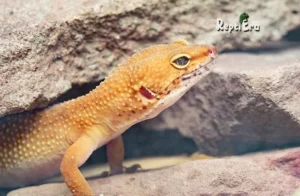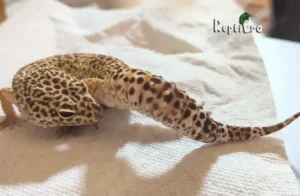When considering the well-being of your leopard gecko, the choice of substrate plays a crucial role. It’s not just about aesthetics; the substrate in your Leo’s tank is where they will walk, run, feed, and even lay eggs. As a ground-dwelling lizard, the type of substrate you select can enhance or deteriorate their quality of life.
Do Leopard Geckos Need Substrate?
It’s surprising to learn that what’s marketed as suitable for this species may not always be the best option. Many substrates that are readily sold are, in fact, unhealthy for them, potentially leading to illness and, in severe cases, death.
In this article, I’ll introduce you to the commonly used substrates and detail their pros and cons.
A terrarium’s substrate is an important part of not just any exotic pet’s life but is particularly vital for leopard geckos. Whether it’s for burrowing, pooping, or general movement, the right and wrong substrates can have a significant impact. While some options are considered good, others are decidedly bad.
It might surprise you, but the decision isn’t always easy. In a nutshell, understanding these factors is key to ensuring the well-being of your cherished pet.
Table of Contents
Best Leopard Gecko Substrates
Natural Stone Slate: These naturally occurring slates are aesthetically pleasing and offer a firm grip for leopard geckos. However, they can be challenging to acquire and install.
Paper Towels: While not the most visually appealing, paper towels serve as a highly functional and safe substrate option, commonly used by breeders of leopard geckos.
Excavator Clay: This unique substrate not only enables the custom creation of burrows and rock-like structures but, once hardened, it closely mimics the natural ground of a gecko’s habitat, adding an element of excitement.
Also Read: WHY IS MY LEOPARD GECKO NOT POOPING
Safe Substrates For Leopard Geckos
Numerous excellent substrate choices are available for leopard gecko tanks, encompassing both natural and synthetic varieties.
1. Paper Towels
When it comes to managing enclosures for baby leopard geckos, who tend to eat and defecate frequently, paper towels emerge as a surprisingly effective substrate. Praised for being cheap and easy to change, they offer a super absorbent solution, making maintenance a breeze.
Many breeders and enthusiasts have favoured this option, especially for young geckos. The white colour of the paper towels makes it easier to spot mites and other potential health issues. While some might argue that such substrates are unnatural, thus preventing geckos from expressing their natural digging behaviour, they provide a good grip for adult individuals, ultimately making life easier. Among various options, the material, texture, colours, weight, and sustainability of paper towels stand out, offering a practical yet effective solution for many gecko keepers.
If you are worried about deforestation and habitat destruction, there are quite options to get “tree-less” paper towels, like Caboo Tree Free Bamboo Paper Towels ».
Also, you can use towels made out of recycled paper, like the Seventh Generation Unbleached Paper Towels
When discussing substrates for leopard geckos, it’s important to note that I do not recommend using perfumed paper towels. The best choice for these sensitive reptiles is those lowest in chemicals, which usually means opting for naturally bleached or unbleached, non-perfumed varieties.
These options ensure the safety and comfort of your gecko without introducing any potentially harmful substances into their environment.
How Much Paper Towel Do I Need In My Terrarium?
Many Leo owners go for just one layer of paper towels. Personally, I would settle for two. Do not put too much because too many layers will turn into a paper pulp mush if it gets substantially wet.
2. Newspapers
While considering substrates for leopard geckos, old newspapers present a cheaper option compared to paper towels. Among their upsides, they are quite absorbent, and using them supports recycling and repurposing, reducing environmental impact.
Although newspapers might seem unnatural and unsightly compared to other substrates, they can add an interesting touch with their funny content. When using a newspaper substrate, it’s advisable to keep the upper layer dry and change it at least once a week, if not longer. The ink used in printing newspapers is generally non-toxic, but to stay on the safe side, allowing for drying time partially resolves the issue of specific newspaper smell.
How Many Newspaper Sheets Do I Need In My Leo Tank?
About five or six layers of newspaper will be about right to make this substrate sturdy and absorbent enough.
3. Reptile Carpet
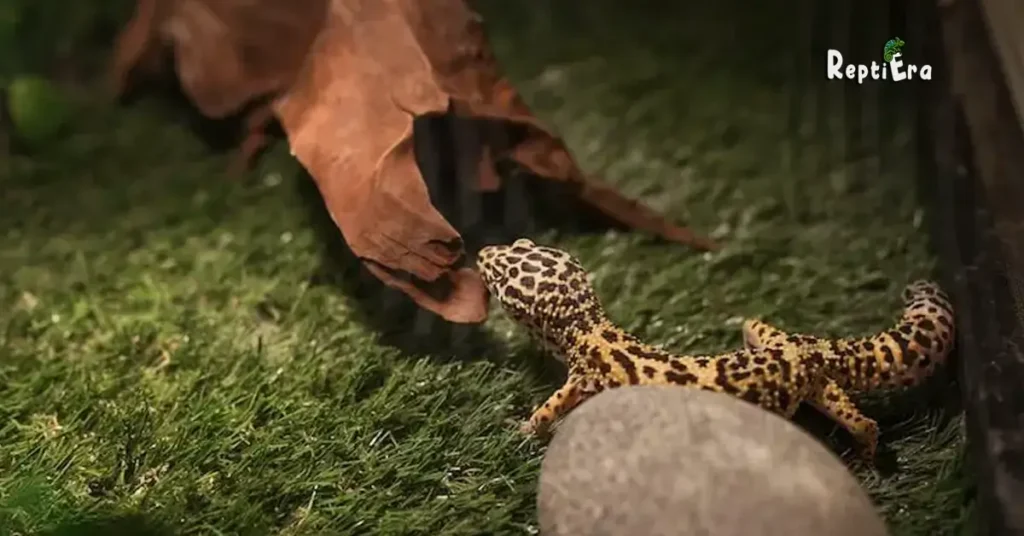
In the realm of substrates for leopard geckos, the Reptile carpet stands out as an artificial substrate that combines absorbency and supportiveness, offering a good grip for walking, unlike some paper substrates. It’s essential to choose a carpet from a proven manufacturer specifically designed for leopard geckos; using the wrong kind of carpet can lead to Leo’s claws getting stuck in the fibre.
Fortunately, brands like Zilla Reptile Terrarium Bedding Substrate Liner Roll make this easier, providing an easy-to-cut material to fit any tank size. These carpets are often pre-treated with biodegradable enzymes to help reduce odours and are easy to wash when soiled, following the manufacturer’s instructions. Ensure there are no fibres sticking out to protect your gecko’s delicate fingers.
A colour like a dark shade of green offers a contrasting background for various leopard gecko morphs, making them stand out in their enclosure.
Zilla Reptile Terrarium Bedding Substrate Liner »
And if you prefer natural materials, an interesting alternative to plastics to consider is reptile carpets/terrarium liners made out of natural coconut fibre, like this Hamiledyi Reptile Carpet ».
How Much Reptile Carpet Do I Need In My Leo Tank?
You only need one layer of reptile carpet in your enclosure. Do everything according to the manufacturer’s instructions. Reptile carpets can come pre-cut to a certain size, or it is up to you to cut it so it cover the bottom of your tank.
Important: Reptile carpets are specialized equipment and are NOT the same thing as regular “human” carpets or astroturf. Do not use any of these in your terrarium.
4. Large River Pebbles (over 2 cm / ~0,8″)
Using larger smooth pebbles or river stones as a natural substrate in a leopard gecko’s habitat can create a visually appealing environment. However, unlike artificial substrates, these large pebbles are not easy to clean.
Typically, leos tend to poop in one corner, allowing for partial cleaning and replacement of the pebbles. The cleaning process involves washing and disinfecting with boiling water, which, while ensuring hygiene, doesn’t equate to easy maintenance. Nevertheless, the material allows for endless re-use, providing a long-term substrate solution.
One of the downsides to using large pebbles in a tank is the inability of leopard geckos to dig. A layer of these pebbles should be thin and loose enough to avoid creating rattling noises as the geckos move. This setup can become problematic when prey items like mealworms escape between the rocks.
To address this, you can feed your lizards using a special tray or tweezers, especially when offering food smaller than the gecko’s head. Additionally, mixes of smaller pebbles or gravel pose a risk of bad impaction if ingested accidentally by the geckos.
How Much River Stones Do I Need For My Leo Tank?
When putting a layer of river pebbles, you should aim for silence and stability – the number of centimetres is not overly important.
5. Stone Slates
<<Stone slabs, slates, and pavers offer an attractive and non-loose substrate option, combining the benefits of true rocks with good grip, and a natural look and feel for leos. These porous materials are easy to clean and provide a rougher texture, ensuring a stable walking surface for your lizards.
When setting up an enclosure, it’s important to ensure that each stone slate is firmly attached to the bottom of the tank, eliminating any wobbling. This prevents the risk of geckos getting hurt or stuck at the edge of the space between the slate and the tank wall.
Some owners place a small amount of sand to anchor and fill spaces between smooth flat stones, creating a more naturalistic environment. Additionally, slate rocks are excellent at holding and distributing heat. However, the risk of ingesting the substrate is still present if the amount of sand is too high, especially in open areas of the tank. >>.
How Many Stone Slates Do I Need In My Leo Tank?
A single-layer slate or carefully arranged pieces should cover the entire bottom of your terrarium. Again, there should be cracks or spaces. Note that the size of the slate that will fit your tank perfectly might be hard to find, and it would be best if you could check with a dealer to see if they can provide you with the exact size you need on the spot.
6. Ceramic Tiles
Ceramic tiles serve as lighter and more affordable cousins to stone slabs, offering a substrate option that is easier to obtain, cut, and install in a leopard gecko’s habitat. However, there can be trouble if the surface is too smooth, as geckos might have difficulty getting a grip, potentially hurting themselves by slipping. This factor is crucial to consider when selecting the right type of ceramic tile for your pet’s enclosure.
How Many Ceramic Tiles Do I Need In My Leo Tank?
You will need a single layer of tiles that should cover the entire bottom of your terrarium. You can use it in combination with a layer of paper towel beneath the tiles.
7. Excavator Clay Substrate
Excavator clay, a new type of substrate on the market, offers a unique experience akin to modelling clay. When moist, it can be shaped and customized to create various scenery elements like caves, burrows, and basking spots. As it dries, it holds its shape firmly in place, adding a touch of fun to building a habitat for your Leo. This substrate is particularly appealing for burrowing lizards who enjoy a seemingly-natural, clay-type environment, similar to their natural habitat. It’s a more creative and structurally stable alternative to pure desert sand.
How Much Excavator Clay Should I Use For My Leo?
Since this is a special type of substrate, you should follow the instructions on the packaging, although the amount of clay you will use will also depend on the structures you want to build.
8. Bioactive
Bioactive substrates are like miniature ecosystems for leopard geckos, comprising natural soil, live plants, and a cleanup crew of live bacteria and small arthropods. These elements work together for waste breakdown, creating a setup that closely mimics their natural habitat.
The typical bioactive setup includes layers of gravel for drainage, topped with soil or clay mixtures, and often adorned with branches to give a more natural, exotic, and wild appearance. For leopard geckos, this allows them to interact with their environment in ways they naturally do in the wild, such as digging and burrowing. The cleaning organisms within the substrate play a crucial role in maintaining a healthy environment.
Setting up a bioactive substrate can be a rewarding yet challenging endeavour. It needs to be fine-tuned to maintain proper temperature and humidity, requiring regular maintenance. While white urates and poop are broken down by the beneficial bacteria in the organic part of the substrate, creating a self-sustaining ecosystem in your reptile tank can be difficult, expensive, and time-consuming. A solid understanding of horticulture is beneficial, and considering the cost and effort involved, it’s a decision that requires careful consideration.
Also Read: HOW TO BOND WITH YOUR LEOPARD GECKO
9. DIY Blended Substrate
Creating a do-it-yourself substrate can be a cheaper alternative to a bioactive setup, offering a cheap, simple, yet unique way to achieve a natural look in your gecko’s enclosure. A popular DIY mix involves blending organic topsoil, play sand, and clay – avoiding calcium sand and beach sand, which can be harmful, especially if they contain fertilizers or pesticides.
The aim is to achieve a consistency that is pliable enough for the gecko to dig in, a crucial aspect of their natural behaviour. This blended substrate can be tailored to suit the specific needs of your tank, and it’s essential to allow it to settle for about 1-2 weeks before introducing your lizard, ensuring the substrate is sturdy and adequately dries out.
One of the advantages of a DIY blended substrate is the control it gives you over the environment in your gecko’s tank. However, it requires regular monitoring of temperatures and moisture levels. Also, it needs to be replaced periodically to prevent bacteria buildup, an essential aspect of maintaining a healthy habitat. The cost of creating this substrate is relatively low, typically around $35 for two or three mixes, making it a budget-friendly option for many gecko owners looking for a balance between functionality and aesthetics.
10. Reptile Sand Mat
Reptile sand mats offer a unique substrate alternative for Leopard Geckos, combining the simplicity of a reptile carpet with a more natural look akin to DIY or bioactive mix substrates. These mats provide a rocky and sandy appearance while ensuring a firm grip for the geckos, without the risk of them swallowing loose grains.
The texture of these mats varies, with some having finer grains and others larger grains, but all are designed to be safe and not too rough on the gecko’s stomach. They are also quite affordable, ranging from about $10 to $40 depending on the size, and are available at most pet stores. The sizes vary too, from 11” x 11” to as large as 47.5” x 17.5”.
Installing a reptile sand mat in a gecko’s enclosure is straightforward. They can be cut to fit using a box cutter, and the adhesive backing can be easily removed for cleaning. Unlike materials like lino, there’s no risk of melting in the tank. Their rough texture makes them suitable for spot-cleaning, but they should be deep-cleaned every two weeks. This involves washing them with soap and water to maintain hygiene in the enclosure, ensuring a clean and comfortable environment for your gecko.
11. Lino
Linoleum, commonly referred to as Lino, is a mat-like flooring option that mimics the appearance of stone, hardwood, or even ceramic and serves as an easy-to-install substrate for leopard geckos. Its appeal lies in its lightweight and flexible nature, making it a hassle-free option for gecko owners.
Despite its benefits, one downside of Lino is that its peel-and-stick installation can be difficult to remove due to the adhesive glue. Additionally, there’s a risk of the material melting under high heat conditions in the enclosure. Nonetheless, it’s an affordable choice, typically costing around $5 per square foot, and available in various styles, including those that resemble stone tiles or wood slats.
When it comes to cleaning, Lino is notably hassle-free. It can be wiped down with a damp cloth and a non-phenol cleaning agent, ensuring the enclosure remains hygienic. This type of substrate should be cleaned regularly to maintain a clean environment for your gecko. Over time, Lino may need to be replaced, but it’s generally considered sustainable and long-lasting, making it a practical and economical choice for many reptile enthusiasts.
12. Shelf Liner
Shelf Liner is an increasingly popular substrate choice for leopard gecko owners, known for being affordable and available in bulk. A simple 18” x 100” roll can be a standard purchase, often costing around $10 at a hardware store. This option, with its adhesive backing and non-perforated design, is both attractive and practical, providing a natural and safe environment for your gecko.
Despite its cheap price, the Shelf Liner does pose a problem as an insulator rather than a conductor, which can increase the output of heat fixtures in the tank. This change in surface temperature is particularly important for basking areas, requiring careful monitoring to ensure a safe and comfortable habitat for your leopard gecko.
Also Read: HOW TO TRAVEL WITH A LEOPARD GECKO
The Controversial Coconut Coir (Eco Earth)
Coconut coir, also known as Eco Earth or coco, is a debated substrate among leopard gecko keepers, often referred to as Controversy. It’s affordable, looks natural, and boasts antimicrobial properties that help prevent rotting mold and bad odours. This moisture-retention substrate is ideal for wet hideouts, while its dry form serves as a drier hiding place in the terrarium.
However, it’s not without issues. If swallowed, it poses a risk of impaction, despite being marketed as a nutritional supplement. Hobbyists debate the dangers and downsides, especially in a Leo tank where mature female leos may experience commotion due to its dust.
Dry coco near food areas can lead to potential hazards. It’s crucial to recognize these risks and consider safer, simplest, and more natural substrate options that are local to your leos’ needs. A disclaimer for those using sand or coconut fiber: ensure there are no sharp rocks or 3D rock backgrounds where your leos could spend time, to minimize the risk of them ingesting dry coco.
(If you’re still opting for coconut coir, make sure that you get a brand that is made out of organically-grown coconut and, ideally, intended for use in reptile and amphibian tanks. You will usually have two choices: to get loose bagged substrate, like this 10-quart Fluker’s Loose Coconut Bedding for Reptiles ».
or a compressed coco brick or coco block, like Josh’s Frogs Coco Block Fine Coco Fiber, which will expand to 38 quarts when submerged into (ideally dechlorinated) water.
Josh’s Frogs Coco Block Fine Coco Fiber »
How Much Coconut Coir Should I Use In My Leo Tank?
A layer of about 1 cm (less than half an inch) will be enough to satisfy the basic needs for stable movement of your pets, as well as the absorbance level. However, if you wish for your leos to have the possibility to really dig into the substrate, feel free to put in a thicker layer.
Leopard Gecko Moist Hide Substrates
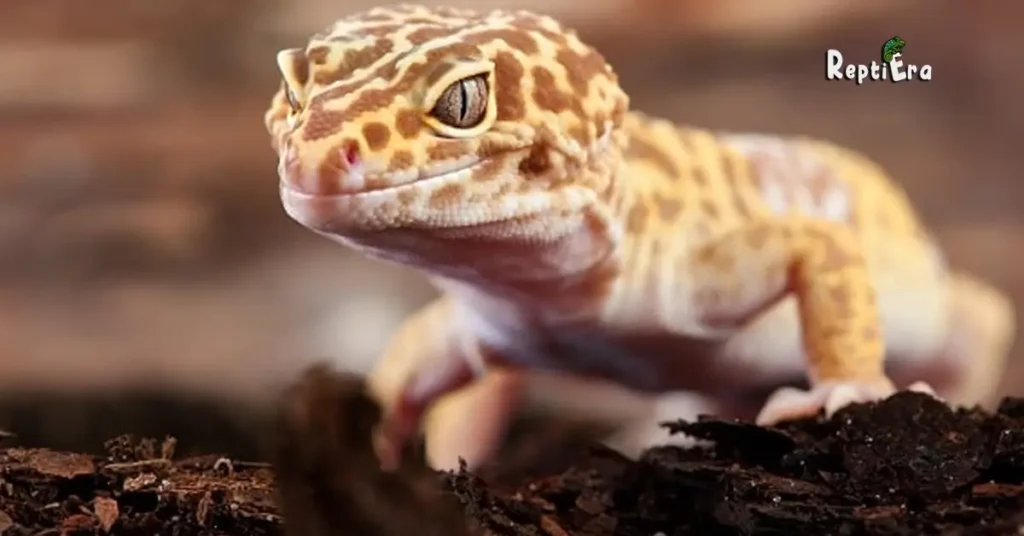
When setting up a moist hide for a leopard gecko, choosing the right substrate is key. A small amount of additional, complementary substrate inside your leo’s cave or hide box can aid in moisture retention, crucial for their health and comfort. However, it’s important to select substrates that are good at retaining moisture yet prone to neither mold nor other issues, ensuring a safe and hygienic environment for your gecko.
Frequently chosen substrates for damp hideaways include these options.
1. Coconut Coir (or Eco Earth)
Coconut fiber, often referred to as coco, is a popular general substrate for leopard geckos but comes with its own downsides. As a moist hide substrate, it effectively holds moisture but can become mouldy if not maintained properly. Leos love to dig and may lay eggs in it, so it’s essential to set it up with freshly soaked fiber.
However, be aware that over time, this substrate can develop a scent that’s funkier than desired, necessitating a regular change. Coconut coir, available as coco bricks or blocks, and also bagged and loose for terrarium use, is offered by brands like Fluker’s and Caribsea Coco Soft Reptiles Bedding, made from fresh organic coconut husks.
2. Sphagnum moss
Sphagnum moss, with its texture and similar properties to coconut coir, offers an alternative substrate choice. It’s coarse and stringy, unlike the finer coconut fiber, and is generally considered safe for use in a leopard gecko’s habitat. While coco is a staple in the Leo community, sphagnum moss has its merits, particularly as a moist hide substrate.
There have been occasional reports of ingestion by lizards, leading to impaction, but this is less likely compared to coconut fibre. For optimum moisture retention, brands like Josh’s Frogs Sphagnum Moss offer a chunky yet manageable substrate that can be laid in a thin layer, specifically intended for terrarium use.
3. Wet paper towels
Despite the risk of ingestion associated with loose substrates, many owners prefer using paper towels, especially for moist hides, though they’re not 100% safe. Lizards like leopard geckos, particularly females who dig to lay eggs or males seeking a place to hesitate, might proceed to ingest pieces of the substrate.
This can lead to egg binding, a critical condition, or impaction. There have been case reports of Leos accidentally swallowing pieces of paper, especially during shedding when skin can get dangerously entangled with coconut fibre or sphagnum moss, making these substrates best to avoid in such settings.
Related Post: DO LEOPARD GECKOS NEED BATHS
Unsafe Leopard Gecko Substrates
1. Sand
<<While leos originate from a dry, desert environment, the popular image of a Sahara-like, sandy desert landscape often leads pet shops to recommend sand or calcium sand as a substrate. However, the truth is, that their natural habitat is more akin to a rocky Asian desert or grassland, with soil that’s hard and lacks the consistency of sand. An all-sand enclosure is not only unnatural for leopard geckos, but it also poses safety issues.
The risk is especially high with loose substrates as geckos may swallow substrate material during feeding, a concern, particularly for younger individuals who are voracious and impulsive eaters. Even with careful feeding techniques, like using a special tray or tweezers, geckos might still lick and eat small particles of sand or gravel, mistakenly seeking mineral intake to aid digestion. Unfortunately, uncontrolled intake can lead to impaction, a blockage in the intestines that can be serious to treat and potentially fatal.
Calcium sand, often touted as digestible, works in theory but in practice, larger amounts can physically shut down a lizard’s tiny, delicate bowels. Even if deficient in calcium, geckos licking calci-sand can have a dangerous effect. While a healthy adult, if properly supplemented, might not ingest enough fine-grained sand to cause harm, the chances of ingestion increase.
Tip: To reduce the risk of particle ingestion, some keepers feed their leopard geckos in another enclosure with a paper towel substrate. Calcium-based sand, although advertised as digestible, doesn’t provide a fail-safe option against bowel impaction. In some cases, vet intervention and surgery are required. A multivitamin supplement is a better way to meet their calcium needs and avoid MBD (Metabolic Bone Disease).
When it comes to impaction, it can be prevented by choosing the right substrate and food choices. A leopard gecko can suffer and die from a terrible health issue like impaction caused by the wrong substrate. Some leo owners still use sand, but when it comes to keeping leos, more specialized reptile sand is considered safer than regular, coarse, or playground sand, river sand, and aquarium sand.>>
(Bottom line: Your gecko will not miss out on anything if you skip using sand. Period.)
2. Pine, Fir and Cedar
When it comes to selecting substrates for leopard geckos, Pine, Fir, and Cedar are types of wood that should be avoided. These woods contain oils that are toxic to reptiles. Despite their availability and common use in other contexts, they should not be used as bedding in a gecko’s enclosure. Their harmful properties can pose significant health risks to your pet.
3. Coconut Fiber
Coconut Fiber is a substrate often considered for Leopard Geckos, but it should be used with caution. While it’s known to hold moisture well, this can cause respiratory or skin infections in these reptiles, particularly under hot temperatures. Additionally, this material can become quite dusty, posing a risk if accidentally eaten by geckos. Due to these potential health concerns, Coconut Fiber is generally not recommended as a substrate for Leopard Geckos.
4. Corn Cob
While Corn Cob granules are cheap and available in bulk, they are not recommended for use in leopard gecko enclosures. When these granules get wet, they can facilitate rapid fungal and bacterial growth, leading to serious health issues like mouth rot. Furthermore, the size of the granules is a concern; they are often too large and can get lodged in a gecko’s throat during their natural licking behaviour. This risk makes Corn Cob an unsuitable and potentially dangerous substrate for leopard geckos.
5. Ground Walnut Shell
Ground Walnut Shell is often sold as a desert sand alternative, touted for its natural appearance, but it comes with significant dangers as a substrate for leopard geckos. Much like corn cob, it poses risks due to small particles that are sharp and can cause impaction or gastrointestinal inflammation in leopard geckos. Additionally, similar to the issues with corn cob, Ground Walnut Shell can harbour growing bacteria and fungi when it get wet, further elevating the risk to the health of your pet.
6. Wood Chips
Wood Chips are an abrasive and loose substrate choice that can create challenges in a leopard gecko’s habitat. One significant issue is with insect prey; they can easily escape and hide among the chips, making it impossible for the gecko to find them. This can lead to feeding difficulties and stress for the gecko, making wood chips an impractical choice for their enclosure.
7. Gravel
Using Gravel as a substrate for leopard geckos, often combined with clay, can create a more effective ground cover in their enclosure. However, it comes with its own set of challenges. The loose nature of gravel poses a risk of collapsing tunnels if the leopard gecko digs into it. Additionally, sharp edges on the gravel can irritate the thin skin on the gecko’s underbelly and feet, leading to discomfort and potential injury.
Also Read: WHY DOES MY LEOPARD GECKO STARE AT ME
8. Sphagnum Moss
Sphagnum Moss is particularly suitable for creating a moist hide, essential during the shedding process of leopard geckos, but it’s not recommended as an entire substrate. While it can enhance the décor and positively impact the humidity levels in the enclosure, its use requires caution. Excess moisture in sphagnum moss can lead to bacterial and mould growth, posing health risks to the gecko.
Choosing a Substrate
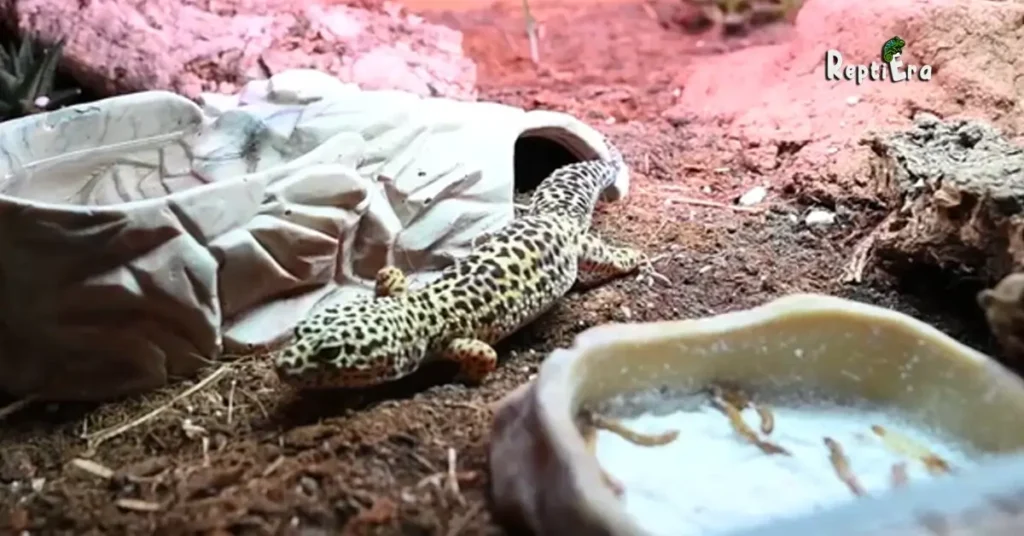
When selecting substrates for a Leopard Gecko, one must consider their happiness and well-being. There are varied opinions on what best replicates their natural habitat, but choosing the right substrate impacts everything from cleaning ease to the pet’s overall health. Using the wrong substrate can significantly affect a gecko’s life in captivity, where they can live an average of 10 to 20 years.
A safe substrate minimizes bacterial growth and the risk of disease, while also encouraging natural behaviour such as hiding, digging, climbing, and burrowing, keeping them happy and active.
The Bioactive Substrate, comprising a layer of gravel for drainage, topped with soil or clay mixtures, and decorated with live plants and branches, needs to be fine-tuned for temperature and humidity. This type of setup requires regular maintenance, but the presence of white urates, good bacteria, and dark organic matter in the enclosure indicates a healthy environment.
For a DIY approach, blending organic topsoil, and play sand, and avoiding beach sand, beech wood chips, and calcium sand is crucial. The substrate should be pesticide-free and fertilizer-free. This blend should settle in the tank for about 1-2 weeks to avoid bacteria buildup.
Ceramic Tile is another option, offering easy temperature regulation and cleaning, but care must be taken with the grout and any sharp edges. Adding plants, rocks, and hiding shelters can make the enclosure more natural. These elements absorb heat well from either an overhead or under-tank heat lamp.
Earthenware or terracotta clay pots can be used in a vivarium, though they are hard to clean if unglazed. Reptile Carpet is a simpler choice, but it needs to be replaced after about five washes. Paper towels can be used, especially under a heat source, ensuring the temperature is regulated via a thermostat and monitored with a thermometer to maintain around 80 degrees.
However, some of the worst substrate options include gravel, wood chips, sand, and coconut fiber, due to the risk of bowel impaction. Fir, cedar, and pine substrates contain oils that are toxic and can cause respiratory problems. These materials can also be sharp and may collapse, posing risks to the gecko.
FAQs
What is the best substrate for a house gecko?
For house geckos, a substrate that retains moisture like reptile bark or Eco Earth is ideal, providing a natural and comfortable environment.
What is the best low-maintenance gecko?
Leopard geckos are known for being easy to care for, making them the best pet lizards for beginners and children over the age of 8.
What is the cheapest substrate for Leopard Geckos?
Paper towels are a cheap and easy-to-change option, super absorbent for maintenance, and are favoured by breeders and enthusiasts in many enclosures, especially for baby leopard geckos who eat and defecate frequently.
How to Build a Favorable Habitat For Your Leopard Gecko?
To create a natural habitat for your leopard gecko, use large rocks, gravel, or bioactive soil, but for a less natural yet easier-to-clean option, consider sheets of paper or recycled paper bedding like those used for hamsters or reptile carpets.
Do leopard geckos prefer sand?
While some leopard gecko owners have used sand as a substrate, it’s not recommended due to the risk of impactions and other health issues; alternatives like bark or coconut fiber that hold moisture are safer but can still lead to skin infections.
Conclusion
Many enthusiasts have enjoyed finding out about the various types of substrates available for their leopard gecko tanks, underscoring the general importance of this aspect in reptile care. It’s difficult to declare which one is truly the best, as each substrate has its unique benefits and drawbacks. Ultimately, it’s up to you to decide what’s ideal for your leos. The important thing is that your decision is based on solid knowledge and understanding of how different substrates impact the health and well-being of your geckos.
